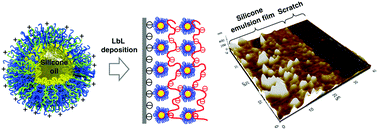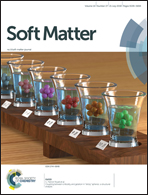Highly stable, electrostatically attractive silicone nanoemulsions produced by interfacial assembly of amphiphilic triblock copolymers
Abstract
This article presents a useful and promising approach for fabricating extremely stable silicone oil nanoemulsions, whose liquid–liquid interface is structured with a thin film of amphiphilic triblock copolymers. For this, two types of amphiphilic triblock polymer, poly(2-methacryloyloxy ethyl phosphorylcholine)-block-poly(ε-caprolactone)-block-poly(2-methacryloyloxy ethyl phosphorylcholine) (PMPC–PCL–PMPC) and poly(2-aminoethyl methacrylate)-block-poly(ε-caprolactone)-block-poly(2-aminoethyl methacrylate) (PAMA–PCL–PAMA), were synthesized by atom transfer radical polymerization. Employing the phase separation technique was critical for the formation of thin polymer interfaces, of less than 10 nm, thus eventually producing structurally stable silicone oil nanoemulsions. The co-assembly of PAMA–PCL–PAMA with PMPC–PCL–PMPC enabled the patching of positive charges on the surface of the emulsion drops. We show that these charged silicone oil nanoemulsions could be used to form a multilayer emulsion thin film by layer-by-layer deposition. Finally, we experimentally demonstrate that the silicone oil nanoemulsions fabricated in this way were highly stable and had the ability to electrostatically interact with hair, which enabled complete coating of the hair surface with a layer of silicone oil.



 Please wait while we load your content...
Please wait while we load your content...